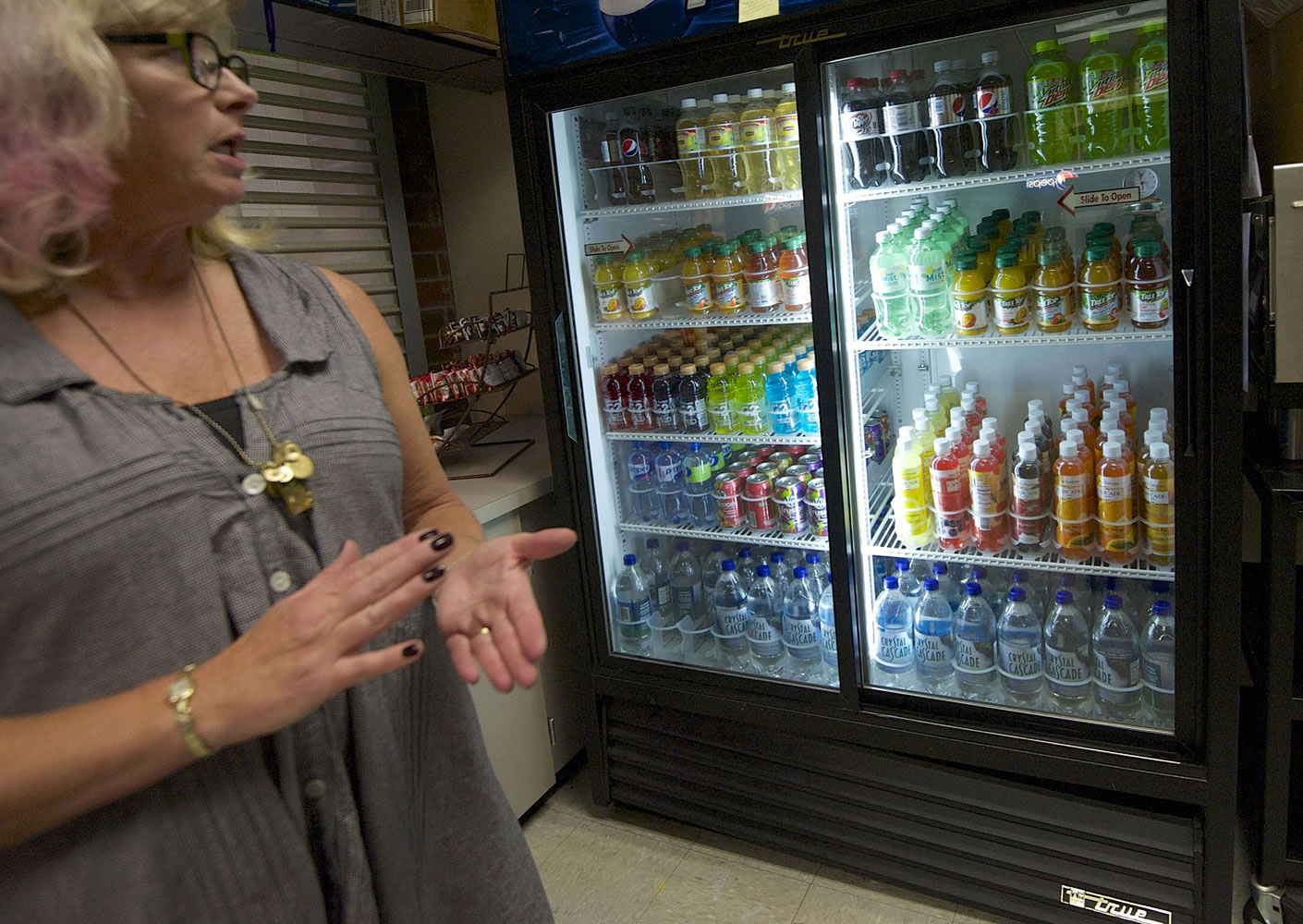Read the Smart Snacks in ?School FAQ
USDA Nutrition Standards for school food: 35-10-35
No more than 35% of daily calories from fat.
No more than 10% of daily calories from saturated fat.
Any pre-packaged food item or beverage may derive no more than 35% of its calories from added sugar.
Heritage High School’s marketing teacher, Shawn Perez, gave last-minute directions to her students as they prepared to celebrate Wednesday’s grand opening of the new, improved menu in the student store, the Wolf Den Cafe. The healthier menu meets the U.S. Department of Agriculture’s nutrition standards of the Healthy, Hunger-Free Kids Act of 2010.
The challenge, as the marketing students found out, will be getting their peers to eat it.
What’s not offered this year that was sold in the school store last year? Bagels. Pepperoni sticks. High-calorie sodas and energy drinks. Neon orange liquid cheese for nachos.
“Michelle Obama ruined our food life,” said Jessie Johnson, 16, a junior, who was eating the cafeteria’s build-your-own burrito with sides of a partial ear of corn and fresh fruit. She topped off her lunch with nonfat chocolate milk. “We’re in high school. We should be able to choose what we eat.”
The healthier food changes were spearheaded by first lady Michelle Obama.
Last school year, the school store served pizza sticks that packed more fat and calories. This year, the pizza is made by Godfather’s Pizza and delivered before lunch begins. Godfather’s changed its recipe to fit the new guidelines, said Perez. The new, healthier pizza is made with whole wheat flour, low-fat cheese, low sodium sauce and no pepperoni. The portion sizes are very small. The pizza slices measure about 2 inches at the base. Both the Hawaiian and the cheese pizza have 170 calories per slice.
“Last year, we had 10 jojos (potatoes),” Johnson said. “Now, it’s like little portions.”
She’s not kidding.
On the new, improved chicken and jojos serving, two lonely bites of baked chicken share a paper tray with four tiny, baked jojo potatoes.
On Wednesday no one from Johnson’s lunch table had purchased food from the Wolf Den, although many other students were buying the food. Three girls standing in the cafeteria each ate one slice of pizza.
“The pizza is better,” said Taylor Kamp, 15, a sophomore. “That’s the only thing that’s better. Everything else sucks.”
“I don’t buy the other stuff,” said Sophia Robles, 16, a junior. “I bring my own food.”
“I go out. Off campus,” said Danica Haugen, 16, a junior. “To Taco Bell. McDonald’s.”
When she was asked whether she paid attention to whole grains or calories, Haugen said, “No. I don’t need to.”
It’s the first time in 30 years the USDA has made major changes to the school food program. Reducing childhood obesity is the primary reason behind the changes. All schools across the nation have changed their offerings to meet the new standards, which require school lunches to offer more fruit, vegetables and whole grains.
Another part of that initiative, the Smart Snacks in School program, went into effect July 1. That program mandates that food sold in schools, including vending machines, school stores and school fundraisers, must echo those changes.
Now, the first ingredient in any food sold in schools must be a fruit, vegetable, dairy or protein. The food must be whole-grain rich and be limited in calories, fat, sodium and sugar. Beverages must be limited in calories and in size, with the exception of water. All foods and beverages sold to students in schools must follow the 35-10-35 guideline mandated by the USDA’s Smart Snacks in School program. This guideline states these foods may have a maximum of 35 percent of their calories from fat, 10 percent from saturated fat and 35 percent from sugar.
The regulations affect a la carte offerings in school cafeterias and vending machines, but not those available only to faculty and staff.
Healthy … and tasty?
Last spring, Perez’s students had to examine every product sold in the school store and test it against the Smart Snacks product calculator to see whether it met the new standards. If it didn’t, they tweaked the ingredients to see if a modified product could meet the standards. Her students even conducted market research taste tests with student volunteers to determine whether students would buy the healthier options.
Johnson said she participated in the Wolf Den Cafe’s market research taste test last year, but with the changed menu this school year, she isn’t choosing food from the school store. She said part of her decision is that the school store requires cash payment. Free and reduced-prices are not offered as they are with the school lunches sold on the other side of the cafeteria.
Logan Winston, 15, a freshman, was drinking a Diet Mountain Dew with his pizza slice from the Wolf Den Cafe. He said he usually does not drink diet soda, but that’s the only soda available during school hours.
USDA Nutrition Standards for school food: 35-10-35
No more than 35% of daily calories from fat.
No more than 10% of daily calories from saturated fat.
Any pre-packaged food item or beverage may derive no more than 35% of its calories from added sugar.
The new standards apply until 30 minutes after the end of the school day. Then foods that do not meet the standards can be sold.
In the Heritage High School cafeteria, two vending machines can be accessed only after 3 p.m. — 45 minutes after the last bell. Students can purchase large bottles of sugar-laden soda including Mountain Dew Voltage and Pepsi Throwback labeled “made with real sugar.” Those vending machines automatically turn off at midnight, said Danny Orrantia, an associate principal who oversees the Healthier Schools program at Heritage.
The snack vending machines do not contain candy bars or any food high in sugar, sodium or calories. But students can buy 1-ounce packages of baked, whole grain Goldfish crackers, roasted, salted peanuts, granola bars, blueberry pomegranate trail mix or a half-ounce package of 100 percent whole grain white cheddar popcorn.
“The marketing teacher is seeing this as an exciting thing instead of something that’s holding them back,” said Orrantia. “We’re treating it as a learning opportunity for our marketing teacher and those kids to take something where the law has changed and use it, improve it and amp up sales.”





